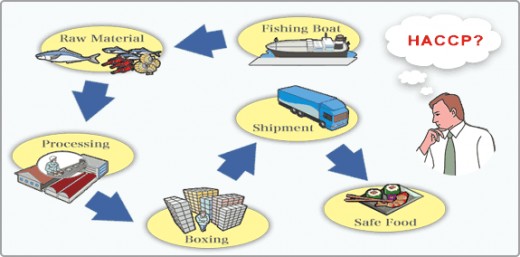WAYS OF ENSURING PROPER FOOD SANITATION

3 Basic Areas in Ensuring Proper Sanitation Standards in the Food Production Facility
· Personal hygiene
· Proper sanitation practices
· Proper food preparation and storage
Personal Hygiene
v Do not work with food if you have any communicable disease or infection
v Bathe or shower daily
v Wear clean uniforms or aprons
v Keep hair neat and clean. Always wear a hat or hair net.
v Keep must aches and beard trimmed and clean. Better yet be clean-shaven.
v Wash hands and exposed parts of arms before work and as often as necessary during work, including:
o After eating, drinking and smoking
o After using the toilet
o After touching or handling anything that maybe contaminated with bacteria
v Cover mouth when coughing and nose when sneezing, and then wash hands.
v Keep your hands away from your face, eyes, hair and arms
v Keep fingernails clean and short. Do not wear nail polish.
v Do not smoke or chew gums while on duty.
v Cover cuts or sores with clean bandages
v Do not sit on worktables.
Proper Sanitation Practices
v Food should be handles using proper equipment.
v A separate tasting spoon should be used. It must not come in contact with food being prepared.
v Equipment should first be washed before they are used.
v Implement and observe daily cleaning schedule of equipment and facilities.
v Use clean rags if possible disposable tissues that will be used only once.
v Hands should not come in contact with the surface where the food is to be placed.
v Handle garbage properly and wash hands thoroughly after handling it.
v Animals should not be allowed in food preparation areas.
v Pest/vermin control program should be implemented and observed.
o Clean all areas and keep them dry
o Cover and elevate garbage and other perishables.
o Keep food covered and refrigerated
o Check all new items from pests
o Store food away from walls
o Prevent access of vermin and pests
o Have a regular pest control program.
Proper Food Preparation and Storage
v Use only fresh ingredients
v Wash all fruits and vegetables and other ingredients before using
v Peeled items should not be kept soaked for long periods
v There should be separate chopping boards for cooked and raw ingredients or at least always wash before reusing for other purpose
v Mise en place and pre-production should be just enough
v Cook meat and poultry to the safe range of doneness.
v Avoid cross contamination by organizing storage properly and separating cooked food from raw food storage.
v Keep all stored items tightly covered.
v Avoid spoilage by observing a first –in, first-out (FIFO) practice of string and using ingredients.
v Have a regular storage-cleaning schedule.
v Milk and cream are very perishable and should be kept in their original containers and refrigerated at a temperature of 40⁰F
v Fats and oils should be stored should be stored at low temperatures in closed opaque containers.
v Never keep food in the danger zone (between 7.2⁰C to 62.8⁰C), especially at room temperature.
v Do not used canned products with bulged cans.
v Reheat properly by moving away from the danger zone quickly.
v Use proper cooling method
v Thaw food properly
Cleaning and Sanitizing Equipment
Cleaning means removing visible oil and stains
Sanitizing means killing disease-causing bacteria
Two ways of killing bacteria are
· By heat
· By chemicals
Procedures for Manual Dishwashing
· Scrape and Rinse
· Wash
· Rinse
· Sanitize
· Drain and Air Dry
Mechanical Dishwashing
Procedures for Mechanical Dishwashing
· Scrape and rinse
· Rack dishes so that dishwasher spray will strike all surfaces
· Run machine for a full cycle
· Sanitizing temperature
· Air-dry and inspect dishes.
Basic Method of Pest Control
· Build Them Out
v Block all possible rodent entrances, including structural defects in the building
v Put screens on all windows and doors
v Make sure all doors are self-closing, or install fly fans or air curtains.
v Inspect incoming supplies for signs of insect infestation
· Eliminate Harborage and Breeding Places
v Repair holes in walls and floors, and any other structural defects
v Eliminate narrow spaces between and behind equipment, counters, or other fixtures and hollow spaces made by false button in counters, cabinets etc.
v Store food supplies off the floor
v Seal all the cracks and crevices.
v Remove all fly breeding places inside and out garbage, manure and general fifth.
· Eliminate Food Supplies
v Keep all foods tightly covered or wrapped
v Keep garbage containers tightly covered and use metal garbage cans
v Clean up all spilled food
v General sanitation
· Exterminate
Extermination is only a temporary solution.
<script async src="https://pagead2.googlesyndication.com/pagead/js/adsbygoogle.js?client=ca-pub-6531909766822314"
crossorigin="anonymous"></script>


